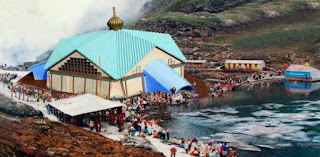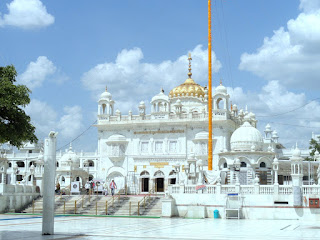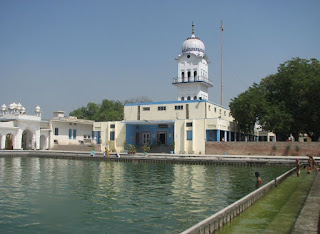Hemkund Sahib
Hemkund Sahib (also spelled Hemkunt), formally known as Gurudwara Sri Hemkund Sahib Ji, is a Sikh place of worship and pilgrimage site in Chamoli district, Uttarakhand, India. It is devoted to Guru Gobind Singh (1666–1708), the tenth Sikh Guru, and finds mention in Dasam Granth, a work dictated by Guruji himself. With its setting of a glacial lake surrounded by seven mountain peaks, each adorned by a Nishan Sahib on its cliff, it is according to the Survey of India located in the Himalayas at an elevation of 4,632 meters (15,197 feet). It is approached from Gobindghat on the Rishikesh-Badrinath highway. The main town near Gobindghat is Joshimath.
Hemkunt is a Sanskrit name derived from Hem ("Snow") and Kund ("bowl"). Dasam Granth says this is the place where Pandu Raja practiced Yoga. In addition, the Dasam Granth says God ordered Sikh Guru Gobind Singh to take birth while he was in deep meditation at the mount of Hemkunt.
It was during the thirties of the twentieth century that the place was discovered by Sant Sohan Singh and Bhai Modam Singh. Bhai Vir Singh, Sikh savant and a leading figure of the Singh Sabha movement , played an important role first in helping these two gentlemen by verifying for them the location of the place and later by providing financial support for building a gurudwara at Hemkunt. Collective efforts of Sikh pioneers backed by the community support led to the construction of gurudwaras en route including Gobind Ghat (6,000 feet) and Gobind Dham (10,500 feet).
In spite of difficult terrain where Hemkunt is situated, devotees from all over the world make it to this unique Sikh shrine every summer. On the way they also visit other important gurdwaras in Rishikesh, Srinagar and Joshimath. On their way back they pay homage at Paonta Sahib, Bhangani Sahib, Tirgarhi Sahib and Shergah Sahib Gurdwaras. Apart from enjoying scenic beauty of the snow-clad peaks and taking a dip into visit the world famous Valley of Flowers not far from Sri Hemkunt Sahib.
History
Long before the Sikhs started frequenting Sri Hemkunt Sahib,the local inhabitants of that area held the lake there with great awe and reverence and called the area around it lokpal, i.e. sustainer of people. In spite of the fact that Hemkunt was mentioned in the autobiography of Guru Gobind Singh, its site remained in oblivion for well over two centuries. This happened in spite of indication of its location having been provided been provided in the guru's own account. It was the Sikh historian-poet Bhai Santokh Singh(1787-1843) who set his imagination to describe and elaborate the story of the Dusht daman, the name the chose for the guru (literally' vanquisher of the evil').
He also provided the description of his tapasthan or the place where he mediated. In the late nineteenth century , a Nirmala scholar, Pandit Tara Singh Narotam , prepared a compendium of the various Sikh pilgrim spots along with their description . That included Sri Hemkunt Sahib. On the basis of the indication provided in the Mahabharata (1:199) about the site where the pandu king had mediated. Narotam trekked up to the spot and was able to verify the site of Sri Hemkunt Sahib.
More recently, the well-known poet-historian-the ologian, Bhai Vir Singh (AD 1872-1957), carefully examined Narotam's evidence relating to the discovery of Sri Hemkunt Sahib and accepted it to be authentic .He provided an elaborated description of spot in his biography of the tenth guru, Kalghidhar Chamatkar, employing more scientific information about the flora and fauna seen at such an attitude. However, the first person to get attracted towards the task of discovering the actual location of the tapasthan was Sant Sohan Singh (of Tehri, Garhwal ) a retired granthi from the army. He had been inspired by the description of the spot in the work of Bhai Vir Singh. He trekked up the holy spot a number of times. In 1934 , he visited the spot in the company of Baba Kartar Singh Bedi, and came back determined to set up a gurdwara there. He met Bhai Vir Singh, who also sensed that the spot that the sant with the necessary material support and furnished him with the wherewithal required for setting up a gurudwara.
The sant, along with Havaldar Baba Modan Singh, engaged a contractor and had a ten-foot square room for the gurudwara constructed there. By installing the scared volume of Sri Guru Granth Sahib in the room they had built, they established a gurudwara. In 1960, the havaldar established a seven-member trust-gurdwara Hemkunt Sahib Management Trust. The founder members of the trust were Havaldar Modan Singh , Colonel Joginder Singh Mann, S.Shamsher Singh, S.Raghubir Singh Kabaria, Baba Gurmukh Singh, S.Gurbaksh Singh Bindra and Colonel Amar Singh. This Trust not only took over the management of Sri Hemkunt Sahib but also established gurudwaras all along the path to it -in Haridwar, Rishikesh, Srinagar , Joshimath, Gobind Ghat and Gobind Dham. In all these places, the Trust steadily upgraded the facilities for the increasing number of pilgrim.
Travel
Hemkund is inaccessible from October through April because of snow bound paths and glaciers. Sikh pilgrims arrive in May and set to work to repair the damage to the path over the winter, which tradition is called kar seva ("selfless service"), a concept which forms an important tenet of the Sikh faith.
The take-off point for Hemkund Sahib is the town of Govindghat about 275 kilometres (171 mi) from Rishikesh. The 13 kilometres (8.1 mi) trek is along a reasonably well maintained path to the village of Ghangaria (also called Govinddham). This path can be covered either by walk or by pony and a Gurudwara here gives shelter to pilgrims. In addition there are a few hotels and a camp ground with tents and mattresses. A 1,100-metre (3,600 ft)climb on a 6-kilometre (3.7 mi) of stone paved path leads Hemkund. Overnight stay is not allowed at Hemkund Sahib and so it is necessary to leave by 2 PM to make it back to Govindghat by nightfall.
From Delhi, tourists take the train to Haridwar and then travel by bus to Govindghat via Rishikesh. It is also possible to drive from Delhi to Govindghat, a distance of about 500 kilometres (310 mi) which takes around 18 hours to cover. Recently, an Indian airline company has started a helicopter service between Govindghat and Ghangria. The flight takes about 5 minutes.
A recent study examining altitude sickness at Hemkund Sahib found that almost one-third of pilgrims who traveled to Hemkund suffered from Acute Mountain Sickness (a form of altitude sickness). As approximately 150,000 pilgrims are believed to travel to Hemkund Sahib each trekking season, almost 50,000 people are at risk of developing Acute Mountain Sickness each year. The authors stated the difficult nature of the trek, limited water consumption and lack of awareness regarding altitude sickness as the main contributory factors.
2013 North India floods, took a heavy toll on the route to Hemkund Sahib. Part of the gurdwara, at Govindghat collapsed, including the langar hall, which collapsed into the river, the parking lot was swept away, only bridge above the Alaknanda River was broken and the building next to it, and the entire footpath at 14,200ft, leading to Hemkund Sahib, from Govindghat was swept away.
Hemkunt is a Sanskrit name derived from Hem ("Snow") and Kund ("bowl"). Dasam Granth says this is the place where Pandu Raja practiced Yoga. In addition, the Dasam Granth says God ordered Sikh Guru Gobind Singh to take birth while he was in deep meditation at the mount of Hemkunt.
It was during the thirties of the twentieth century that the place was discovered by Sant Sohan Singh and Bhai Modam Singh. Bhai Vir Singh, Sikh savant and a leading figure of the Singh Sabha movement , played an important role first in helping these two gentlemen by verifying for them the location of the place and later by providing financial support for building a gurudwara at Hemkunt. Collective efforts of Sikh pioneers backed by the community support led to the construction of gurudwaras en route including Gobind Ghat (6,000 feet) and Gobind Dham (10,500 feet).
In spite of difficult terrain where Hemkunt is situated, devotees from all over the world make it to this unique Sikh shrine every summer. On the way they also visit other important gurdwaras in Rishikesh, Srinagar and Joshimath. On their way back they pay homage at Paonta Sahib, Bhangani Sahib, Tirgarhi Sahib and Shergah Sahib Gurdwaras. Apart from enjoying scenic beauty of the snow-clad peaks and taking a dip into visit the world famous Valley of Flowers not far from Sri Hemkunt Sahib.
History
Long before the Sikhs started frequenting Sri Hemkunt Sahib,the local inhabitants of that area held the lake there with great awe and reverence and called the area around it lokpal, i.e. sustainer of people. In spite of the fact that Hemkunt was mentioned in the autobiography of Guru Gobind Singh, its site remained in oblivion for well over two centuries. This happened in spite of indication of its location having been provided been provided in the guru's own account. It was the Sikh historian-poet Bhai Santokh Singh(1787-1843) who set his imagination to describe and elaborate the story of the Dusht daman, the name the chose for the guru (literally' vanquisher of the evil').
He also provided the description of his tapasthan or the place where he mediated. In the late nineteenth century , a Nirmala scholar, Pandit Tara Singh Narotam , prepared a compendium of the various Sikh pilgrim spots along with their description . That included Sri Hemkunt Sahib. On the basis of the indication provided in the Mahabharata (1:199) about the site where the pandu king had mediated. Narotam trekked up to the spot and was able to verify the site of Sri Hemkunt Sahib.
More recently, the well-known poet-historian-the ologian, Bhai Vir Singh (AD 1872-1957), carefully examined Narotam's evidence relating to the discovery of Sri Hemkunt Sahib and accepted it to be authentic .He provided an elaborated description of spot in his biography of the tenth guru, Kalghidhar Chamatkar, employing more scientific information about the flora and fauna seen at such an attitude. However, the first person to get attracted towards the task of discovering the actual location of the tapasthan was Sant Sohan Singh (of Tehri, Garhwal ) a retired granthi from the army. He had been inspired by the description of the spot in the work of Bhai Vir Singh. He trekked up the holy spot a number of times. In 1934 , he visited the spot in the company of Baba Kartar Singh Bedi, and came back determined to set up a gurdwara there. He met Bhai Vir Singh, who also sensed that the spot that the sant with the necessary material support and furnished him with the wherewithal required for setting up a gurudwara.
The sant, along with Havaldar Baba Modan Singh, engaged a contractor and had a ten-foot square room for the gurudwara constructed there. By installing the scared volume of Sri Guru Granth Sahib in the room they had built, they established a gurudwara. In 1960, the havaldar established a seven-member trust-gurdwara Hemkunt Sahib Management Trust. The founder members of the trust were Havaldar Modan Singh , Colonel Joginder Singh Mann, S.Shamsher Singh, S.Raghubir Singh Kabaria, Baba Gurmukh Singh, S.Gurbaksh Singh Bindra and Colonel Amar Singh. This Trust not only took over the management of Sri Hemkunt Sahib but also established gurudwaras all along the path to it -in Haridwar, Rishikesh, Srinagar , Joshimath, Gobind Ghat and Gobind Dham. In all these places, the Trust steadily upgraded the facilities for the increasing number of pilgrim.
Travel
Hemkund is inaccessible from October through April because of snow bound paths and glaciers. Sikh pilgrims arrive in May and set to work to repair the damage to the path over the winter, which tradition is called kar seva ("selfless service"), a concept which forms an important tenet of the Sikh faith.
The take-off point for Hemkund Sahib is the town of Govindghat about 275 kilometres (171 mi) from Rishikesh. The 13 kilometres (8.1 mi) trek is along a reasonably well maintained path to the village of Ghangaria (also called Govinddham). This path can be covered either by walk or by pony and a Gurudwara here gives shelter to pilgrims. In addition there are a few hotels and a camp ground with tents and mattresses. A 1,100-metre (3,600 ft)climb on a 6-kilometre (3.7 mi) of stone paved path leads Hemkund. Overnight stay is not allowed at Hemkund Sahib and so it is necessary to leave by 2 PM to make it back to Govindghat by nightfall.
From Delhi, tourists take the train to Haridwar and then travel by bus to Govindghat via Rishikesh. It is also possible to drive from Delhi to Govindghat, a distance of about 500 kilometres (310 mi) which takes around 18 hours to cover. Recently, an Indian airline company has started a helicopter service between Govindghat and Ghangria. The flight takes about 5 minutes.
A recent study examining altitude sickness at Hemkund Sahib found that almost one-third of pilgrims who traveled to Hemkund suffered from Acute Mountain Sickness (a form of altitude sickness). As approximately 150,000 pilgrims are believed to travel to Hemkund Sahib each trekking season, almost 50,000 people are at risk of developing Acute Mountain Sickness each year. The authors stated the difficult nature of the trek, limited water consumption and lack of awareness regarding altitude sickness as the main contributory factors.
2013 North India floods, took a heavy toll on the route to Hemkund Sahib. Part of the gurdwara, at Govindghat collapsed, including the langar hall, which collapsed into the river, the parking lot was swept away, only bridge above the Alaknanda River was broken and the building next to it, and the entire footpath at 14,200ft, leading to Hemkund Sahib, from Govindghat was swept away.








Comments
Post a Comment